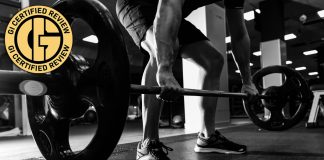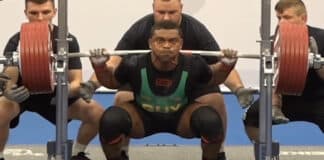
Pendlay rows are a superior back movement that requires a good technique for injury prevention and gains.
Rows are fundamental exercises fitness enthusiasts embrace to develop and fortify their backs, shoulders, and arms while enhancing their pulling strength. Numerous variations of rows, such as the traditional bent-over rows, Meadows rows, and inverted rows, have been proven to build back muscles effectively (1).
The Pendlay row stands out as a unique variation that involves explosively lifting weights from the floor. Named after the weightlifting coach Glenn Pendlay designed this technique, the Pendlay row offers distinct advantages.
This article delves into the Pendlay row, focusing on the specific muscle groups it targets and the benefits it offers athletes. Additionally, it includes a detailed, step-by-step guide on executing this exercise with proper form. To complement this, the guide also suggests excellent alternative exercises for targeting similar muscle groups, ensuring you can maximize your workout efficiency.
Techniques & Muscles Worked
When your Pendlay row form is correct, you get an effective weight training exercise targeting the traps, rhomboids, lats, biceps, and posterior delts. It recruits other secondary muscles that help with stability when doing the routine, such as your abs, obliques, glutes, and hamstrings.
You can execute Pendlay rows with a barbell, though there are options to use other free weights like dumbbells or EZ bars, which can help improve your range of motion and wrist placement. Using resistance bands during this workout can also help to add extra tension, which can improve your gains. Here’s a step-by-step guide to help your Pendlay row form and enhance your execution of this routine.
- Stand in front of the barbell and place your feet shoulder-width apart.
- Keep your knees slightly bent and back straight, then hinge forward till your upper body is parallel to the floor. Maintain this position throughout the movement.
- Grab the bar with an overhand grip, brace your core, and engage your back muscles by rotating your shoulders forward. Your hands should be slightly wider than the shoulders. This is your starting position.
- Next, move upward by pulling the bar and squeezing your lats. Tuck your elbows close to your sides and contract your biceps till the bar almost touches your chest.
- Pause for about two seconds and slowly reverse the movement back to the starting position, making it one rep.
- Perform for as many reps as you desire and return the barbell to the floor.
Benefits
This compound movement offers many benefits once you get your Pendlay row form right. They include building a strong back while recruiting different muscle groups. Here is a list of some of the benefits of this exercise.
Builds a Massive Back
Performing this row primarily targets the back muscles. Rowing from the floor to the upper body with heavy loads hits the back muscles with an extended range of motion, inducing muscle hypertrophy.
Builds Strength & Pulling Power
The Pendlay row is one of the best exercises for building a strong back. During reps, you execute it from the floor instead of suspending the weight as the bent-over row variation requires. Adding a strict Pendlay row form to this exercise also prevents cheating. This boosts strength and growth in the right muscles and enables an easy transition to other exercises like pull-ups, deadlifts, Olympic lifts, and CrossFit training.
Better Range of Motion
Unlike traditional bent-over rows, which limit your range of motion, the Pendlay row form involves lifting from the floor and extending to your chest. This means a better range of motion, improving different joint movements and facilitating the flexion and extension of the targeted muscles. A study shows that a fuller range of motion is better than partials for inducing muscle hypertrophy and strength in the lower limbs (2).
Activates Core Muscles
During this exercise, you activate the core muscles to help with posture, form, and stability. The constant tension you place on these muscles throughout this movement builds and strengthens them. This can help with balance and mobility while reducing your chances of injuries.
Pendlay Row Form Alternatives
The Pendlay row is a compound pull exercise that primarily works the back muscles. It employs a greater range of motion than traditional bent-over or other rows. However, experts advise mixing up your exercises to avoid hitting a plateau when training. Below are some alternative exercises you can incorporate into your back workouts.
Deadlifts
Deadlifts are compound pulling exercises that target the posterior chain muscles – glutes, hamstrings, and back muscles, just like the Pendlay and bent-over row. They’re an excellent routine for building muscle mass in the back and improving grip strength.
Power Cleans
The power clean is a full-body exercise that targets the back, arms, shoulders, core, glutes, hamstrings, quads, and calf muscles. Olympic weightlifters commonly do it with a barbell. It’s also a high-intensity exercise that can help with cardio.
Bear Crawls
Bear crawls are bodyweight exercises that target the shoulders, arms, chest, core, glutes, quads, and hamstrings. Performing this exercise regularly builds strength and total body endurance. You can use resistance bands when doing bear crawls for extra muscle gains.
FAQs
How do you do Pendlay rows correctly?
Get a barbell and place your feet shoulder-width apart. Keep your knees slightly bent and back straight, then hinge forward until your upper body is parallel to the floor. Please refer to the comprehensive exercise guide for instructions on how to do this exercise correctly.
What are Pendlay rows good for?
Pendlay rows are excellent for working your traps, rhomboids, lats, biceps, and shoulders. It recruits other secondary muscles like the glutes, abs, obliques, and hamstrings. These help to keep the body stable and in proper form.
What is the form for the Pendlay row?
Your Pendlay row form must be correct to maximize your gains. Ensure your back is straight throughout the movement and your hips are hinged. Please check the guide above for more information on doing the Pendlay row correctly.
Follow us on Instagram, Facebook, and Twitter for more exercise guides!
References
- Fenwick, C. M., Brown, S. H., & McGill, S. M. (2009). Comparison of different rowing exercises: trunk muscle activation and lumbar spine motion, load, and stiffness. Journal of strength and conditioning research, 23(2), 350–358. https://doi.org/10.1519/JSC.0b013e3181942019
- Pallarés, J. G., Hernández-Belmonte, A., Martínez-Cava, A., Vetrovsky, T., Steffl, M., & Courel-Ibáñez, J. (2021). Effects of range of motion on resistance training adaptations: A systematic review and meta-analysis. Scandinavian journal of medicine & science in sports, 31(10), 1866–1881. https://doi.org/10.1111/sms.14006















